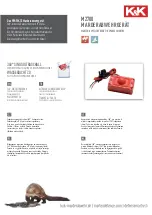
7
Series 1ZC Communicating Sub-Panel Temperature Controller
Figure 5. Process and Linear Input Wiring.
Voltage Inputs: Connect the positive volt-
age input to contact #2; the negative input
to contact #1. Current Inputs: Connect the
positive current input to contact #2; the
negative input to contact #1.
Legend:
Output 1
Contact #6: Relay-N.O. (Normally
Open contact)
Solid-state relay: Load
Process: (+)
Contact #7: Relay-Common
Solid-state relay: Load
Process: (-)
Output 2
Contact #8: Relay-N.O. (Normally
Open contact)
Solid-state relay: Load
Process: (+)
Contact #9: Relay-Common
Solid-state relay: Load
Process: (-)
Output Wiring
Figure 6. Output Wiring. The 1ZC has
two outputs. Each can be configured
with any one of four types of outputs:
mechanical relay, solid-state relay,
pulsed dc, and 4-20 mA.
Figure 4. 2- and 3-Wire RTD Input Wiring.
The 1ZC accepts input from 2- or 3-wire,
100 ohm platinum resistance temperature
detectors (RTDs). Connect 2-wire RTDs to
contacts #1 and #2, with a jumper across
contacts #2 and #3. Keep leads short and
use heavy gauge copper extension wire to
minimize lead resistance, which can result
in a reading error of 5°F per ohm. For long
runs, 3-wire RTDs should be used.
Communications Wiring
Figure 7. Communications Wiring.
The 1ZC conforms to the RS-485
communications standard. Connect
communications wiring to contacts #4
and #5 as indicated in the diagram below.
If the host computer does not have an
RS-485 communications board, then an
RS-232 to RS-485 converter will need to
be used. Note: Contact Athena for a rec-
ommended RS-485 converter. Connect
the converter to your host computer’s
serial communications port. Default
communications settings are: Baud rate =
2400 and Data format = 8-N-1.








































